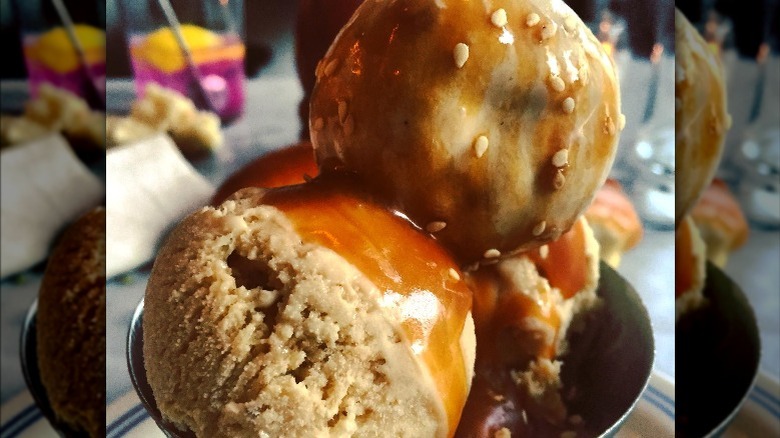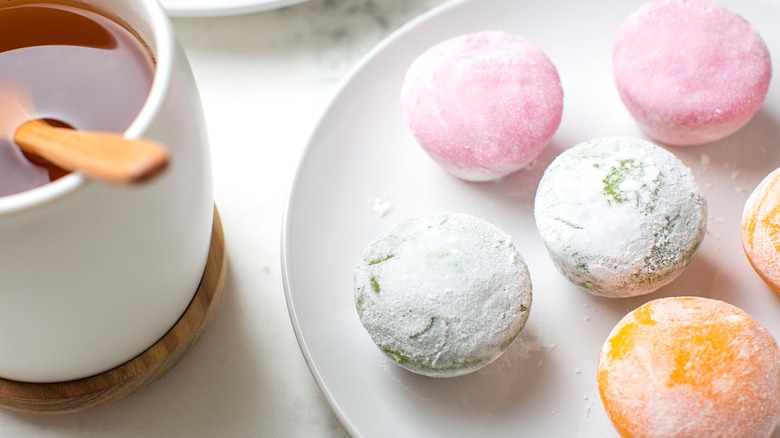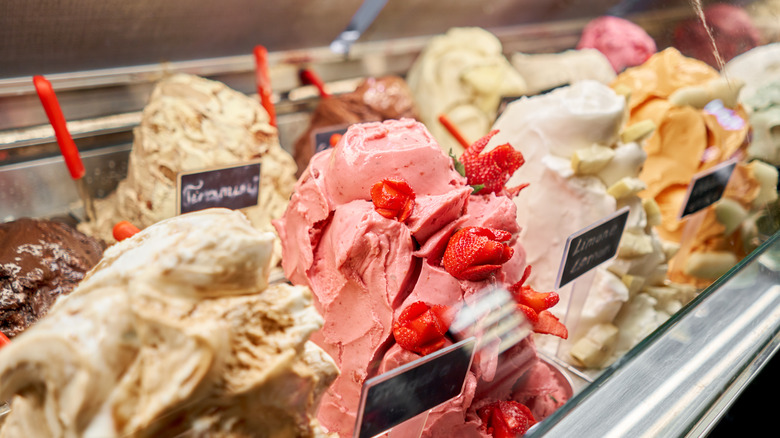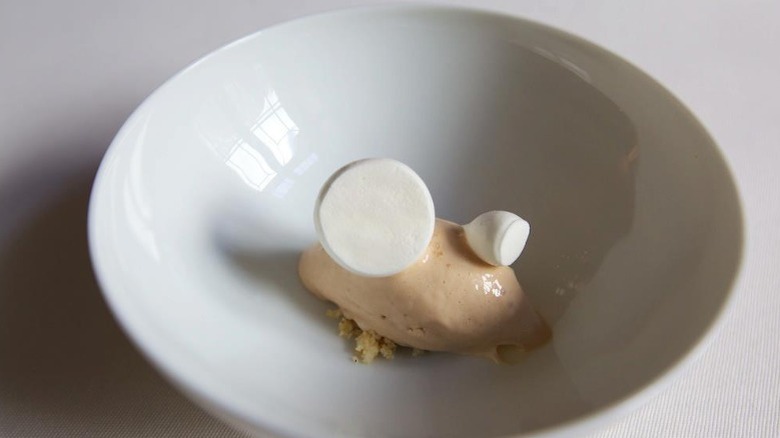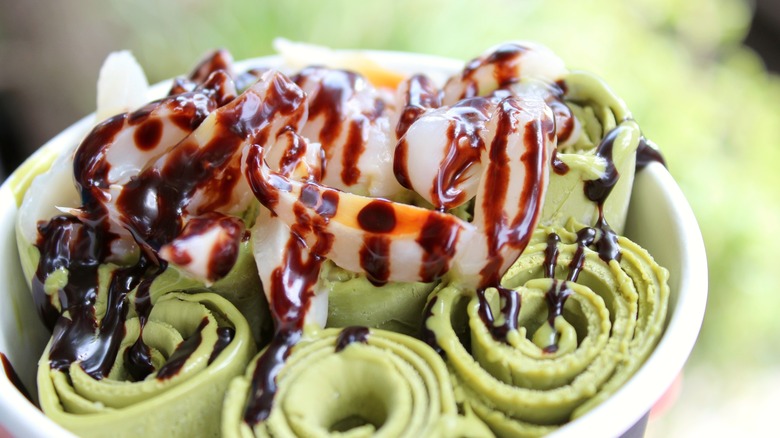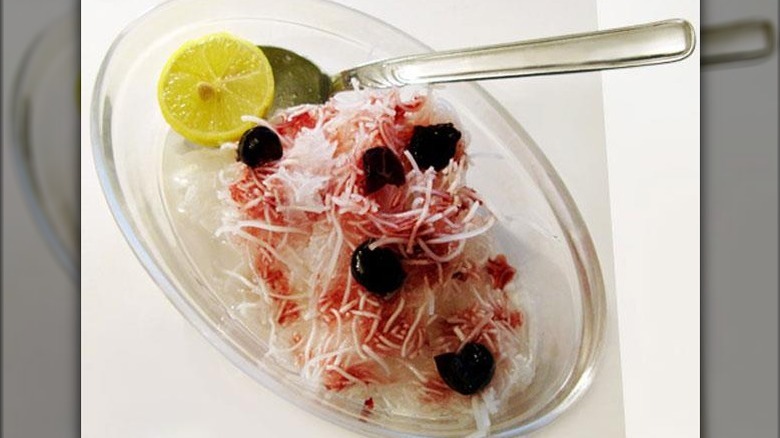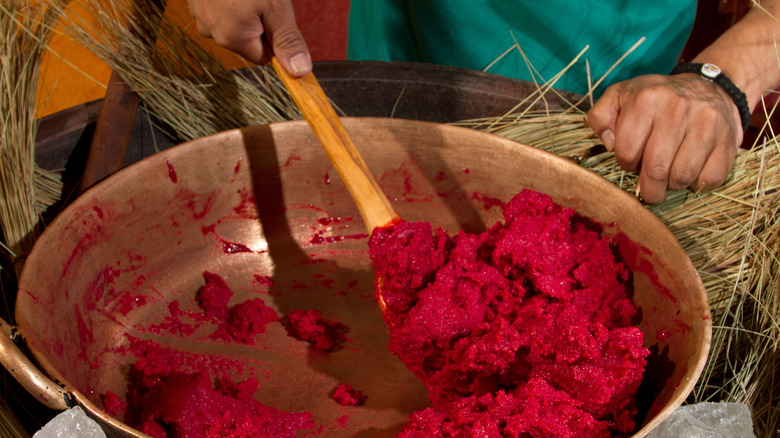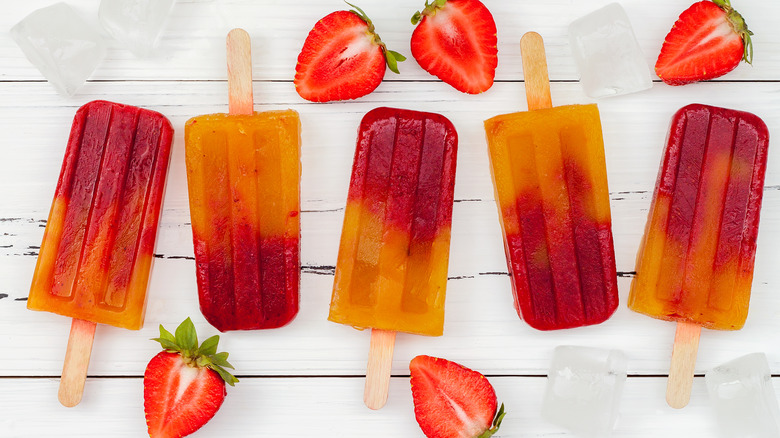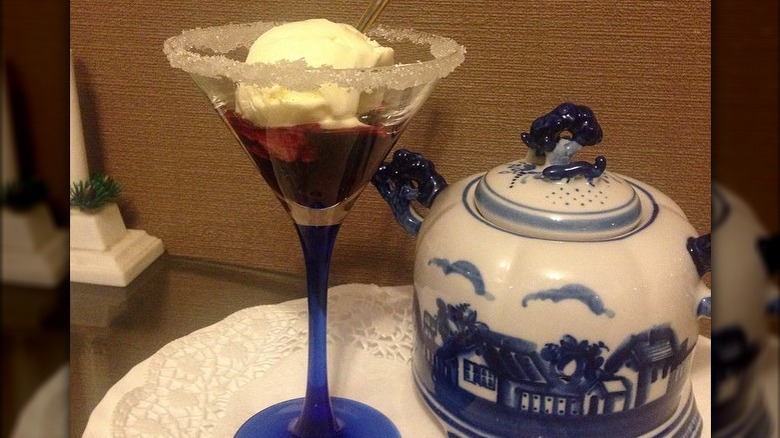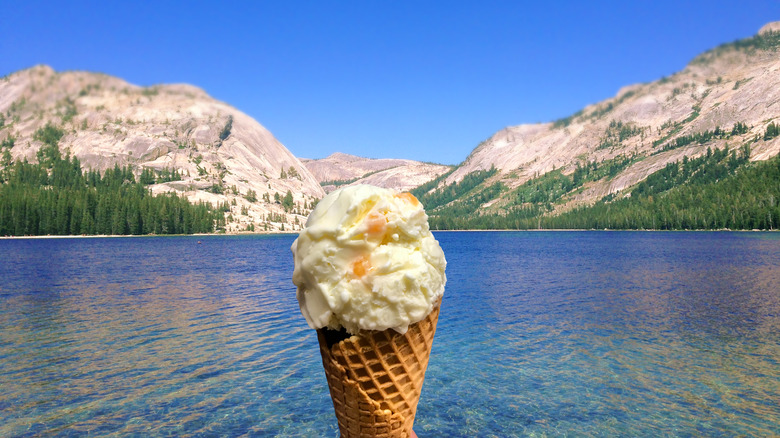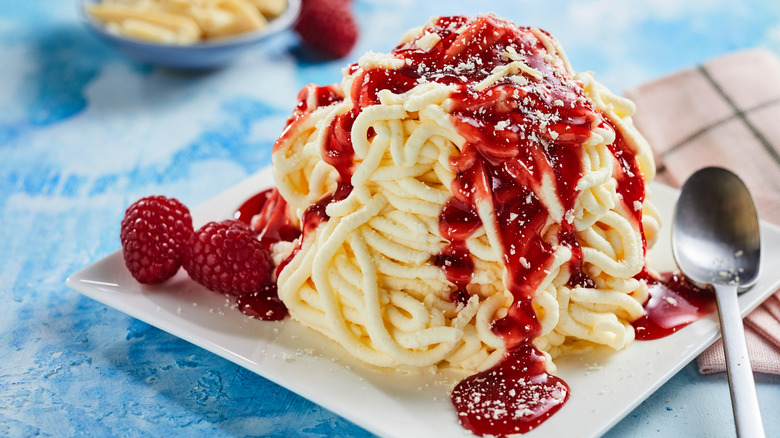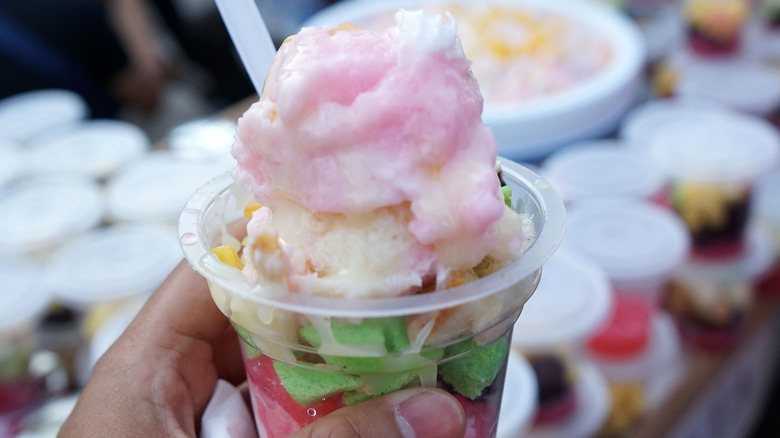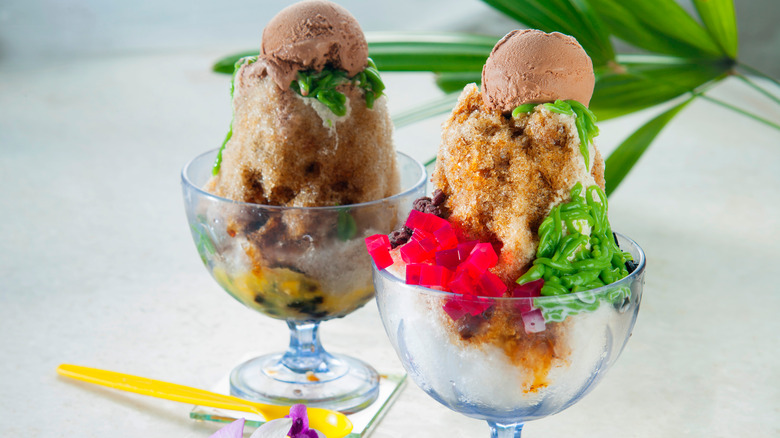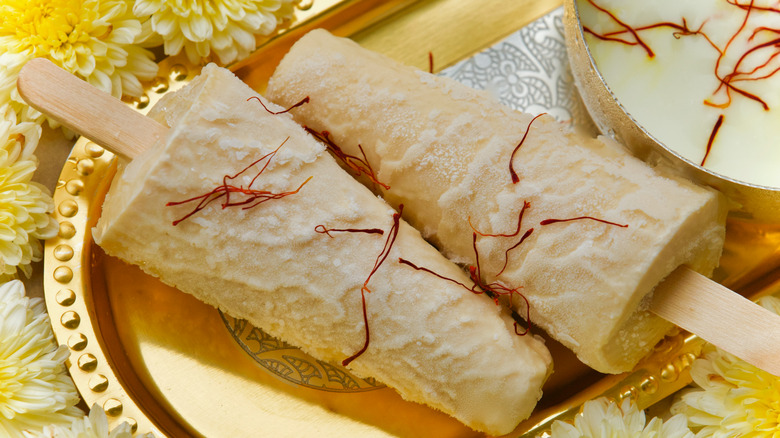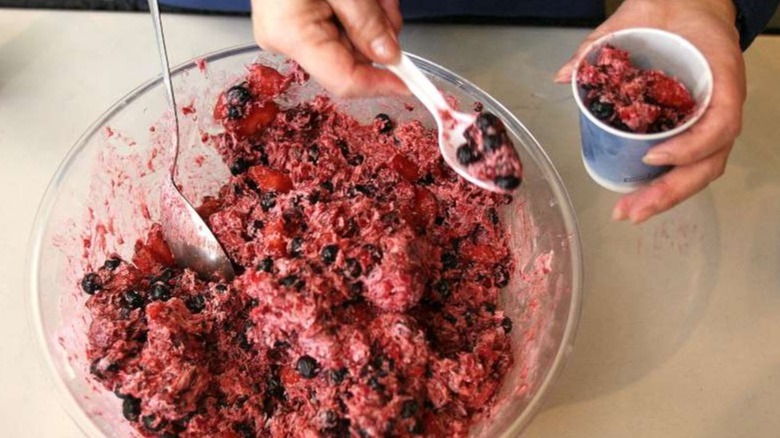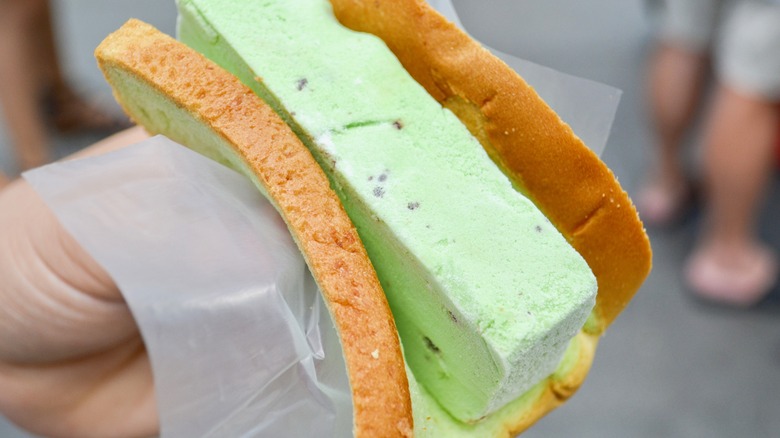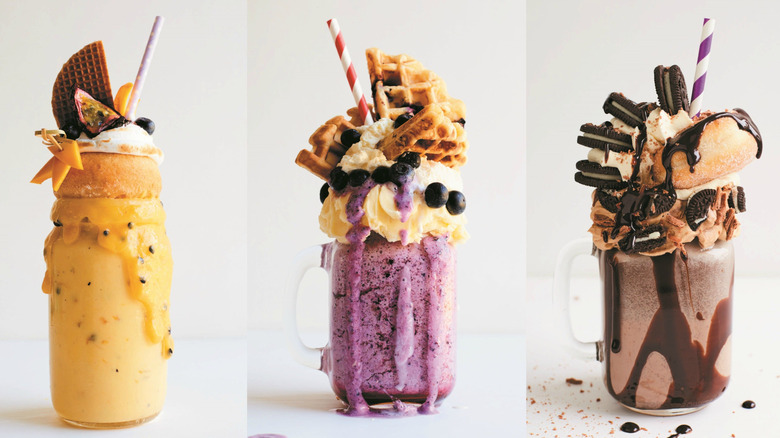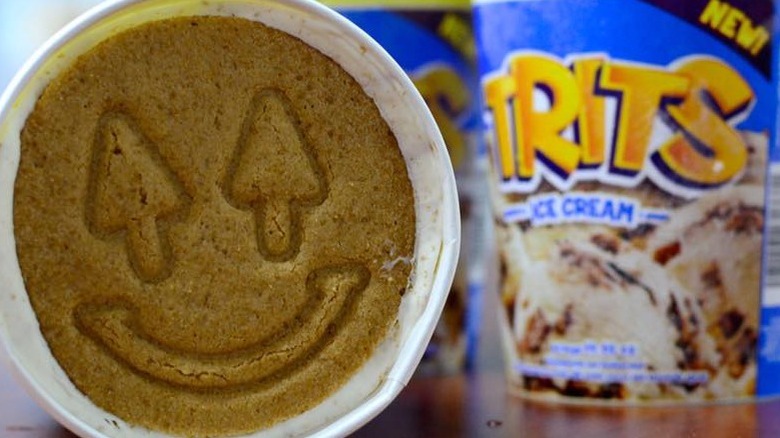How Ice Cream Is Enjoyed Around The World
Whether you scream for classic chocolate or vibrant pink bubblegum ice cream — or anything in between — there's a good chance that when your sweet tooth is calling, the ultimate answer is ice cream. Americans consume over 20 pounds of ice cream per person, per year, making us the unofficial experts on the creamy concoction. But, while we might think we have a handle on the wonderful world of frozen cream, sugar, and flavorings, there are plenty of places worldwide where you can sink your teeth into a frozen dessert that rivals anything you might find stateside.
From a brilliant and simple spin on ice cream sandwiches to decadent ice cream that you can actually stretch and cut with a fork and knife, there's a dazzling world of surprising sweetness out there. So sink your teeth into these fantastic ways to enjoy ice cream worldwide. You might even find a new fave!
Israel: halvah ice cream
Israelis and "in the know" foodies understand the versatility of sesame seeds, which is why halva ice cream (halva being a sesame seed sweet) is such a popular confection. This densely-flavored treat is a welcome diversion from your typical vanilla or chocolate flavor and will have you looking at sesame in a brand new and favorable light. According to the New York Times, more and more people are jumping on this Middle Eastern treat's bandwagon as halva ice cream catches on all over the world.
Halva is a nut- or seed-based concoction with a hefty dose of honey and sugar to even out its earthy, nutty flavor. Its toasty and complex taste are sometimes accented by rich ribbons of caramel or the slightest touch of rosewater. You can even add in extra nuts for additional crunch and texture. However you scoop and serve it up, you need to experience halva at least once in your life.
Japan: mochi ice cream
Individual mochi ice creams are dainty, bite-sized treats from Japan, with a lot going on. First, you have the mochi itself: a sweet, rice-based mixture that's wrapped around small half-moons of ice cream. The contrast between the thin rice paste exterior and smooth ice cream is a winning combination. Basic mochi ice cream tastes delicious on its own, but you can also add chocolate, vanilla extract, matcha, or other flavorings (via Taste of Home) to kick things up a notch or two. Toss a few sprinkles or a drizzle of chocolate on the top, and you're good to go.
While you can certainly find excellent mochi ice cream at Japanese restaurants and specialty shops, places like Costco sell them too. Costco's mochi ice cream was something of a polarizing treat, though, with some patrons saying it's a delicious variation on ice cream, and others wishing that they had left it on the shelf.
Italy: gelato
Gelato is traditional ice cream's more sophisticated cousin — a fusion of the same basic ingredients with slight variations for a denser, more intense flavor and texture. According to Bobby Flay, omitting egg yolks gives gelato its signature smoothness and creaminess. However, the missing egg yolks aren't the only thing that sets gelato apart from your standard ice cream. This decadent dessert is often mixed longer and served several degrees warmer than ice cream, giving it slightly more heft.
Otherwise, the primary components of gelato are the same. You'll find thick cream, milk, sugar, and egg whites in gelato (via Taste Atlas) and nuts, pieces of chocolate, fruit, and other additives. As with traditional ice cream, you can make your gelato as simple or whimsical and wacky as you'd like. Regardless of your flavor fancy, you can expect a tasty creation that strikes an exciting consistency between ice cream and frozen pudding.
Turkey: dondurma
If you love playing with your food, dondurma is for you. This super-rich, stretchy, and utterly delicious ice cream is a true Turkish delight. Part spectacular show, part tasty treat, dondurma is so pliable and dense that you can even eat it with a fork and knife. However, most people sample dondurma the traditional way: in an ice-cream cone. Although you can find dondurma all over Turkey, it's technically from the Kahraman Maras region, also known as the ice-cream capital of Turkey (via Gulf Times).
Dondurma gets its famous stretchiness from salep, a starch harvested from wild orchids. Although it's heartier than basically any other ice cream on the planet, dondurma is still cool, creamy, and delicious. If you're near Istanbul's famous Blue Mosque or Hagia Sophia, you're bound to see plenty of dondurma sellers dotting the square, and if you're smart, you'll pick up a cone or three.
France: foie gras ice cream
While foie gras is certainly a controversial food, this dish of duck or goose liver is also a beloved culinary treat, gracing 5-star kitchens all across the globe. While foie gras is usually served slightly seared, in a terrine, or cold, some chefs elevate it in exciting ways by making it into ice cream. A 2020 article on Symrise In-Sight says savory ice creams are having a moment, with chefs using the icy canvas to show off their flavor pairing skills.
Chef Philippe Faur, the owner of Temptations in southwest France, makes foie gras ice cream to go with some of his savory dishes. The richness and decadent flavor of the foie gras is the perfect foil for ice cream, and it pairs with one of Faur's signature dishes: duck breast ravioli (via Taiwan News). Faur also offers Roquefort and caviar ice creams, but the foie gras is something stunning and memorable, and a unique nod to France.
Thailand: Thai rolled ice cream
Walk down any street in Bangkok, and you're bound to come across one of the most coveted frozen treats in all of Thailand: rolled ice cream. Order up a bowl and prepare yourself for the twin delights of exceptional preparation and unique flavor. Thai rolled ice cream is made right before your eyes, poured onto a frozen sheet, then rolled into perfect thin cylinders. Each one is propped upright in a dish, slathered in toppings, and served immediately (via Splendid Table).
One of the key things that sets rolled ice cream apart from the rest is the perfect ratio of ice cream to toppings. Since each roll is so thin, you'll get plenty of gooey syrup, candies, nuts, or pieces of diced fruit in every bite. For those who want a more traditional preparation with a Thai twist, there's always McDonald's Thailand's pork floss and chili paste McFlurry with a vanilla soft serve base.
Philippines: cheese ice cream
Although many Americans prefer their cheese piping hot and slathered all over noodles, cold scoops of cheese ice cream are the flavor du jour in many parts of the world. In fact, cheddar cheese ice cream is so popular in the Philippines that you can find it hanging out alongside chocolate and vanilla in supermarkets (via Insider). This comfort-food mashup makes a lot of sense. Cheddar cheese gives ice cream that savory and salty zing and works well, texturally, with a crunchy cone.
People who find traditional western flavors a bit too cloying or sweet should take a tip from Filipinos and pile their cones high with a perfectly balanced scoop of cheddar. In fact, you might be able to find just such a scoop near you. Van Leeuwen, a boutique New York City ice cream company, offers Kraft Mac and Cheese Ice Cream to adventurous and savvy foodies who like their soft serve with a touch of childhood cheesy nostalgia.
Iran: fahloodeh
If you want to stretch your horizons far outside the ice cream box, try some Persian faloodeh. This frozen rice noodle-and-syrup treat is worlds away from what you'd get at your neighborhood Dairy Queen. It's a delightful, sweet tooth-tempting dessert of exciting textures and flavors. Faloodeh has plenty of things going for it, but one of the key ones has to be its sophisticated taste. Featuring flavors of rose water, ground nuts, and fruit, faloodeh is a chic dessert bound to please even the pickiest of palates (via New York Times).
According to Atlas Obscura, faloodeh is an ancient desert that dates back to 400 B.C.E. This early version of a high-end snow cone has only evolved to taste more phenomenal over time. Modern faloodeh has flavors that hark back to its ancient roots, plus some newer additions like sour cherries and even a scoop of ice cream.
Ecuador: helado de paila
Don't make the rookie mistake of confusing helados de paila for run-of-the-mill sorbet. This Ecuadorian dessert is bright and fruity with the creamy consistency of ice cream and the bold flavors of a 5-star sorbet. To make it, you need a colossal bronze bowl, plenty of arm strength, and the ability to combine traditional Ecuadorian flavors with ice and sugar. Also, forget your standard cherry, lemon, or lime flavors. Instead, Helados de paila comes in delicious variations like tree tomato, soursop, and coconut.
The process of making helados de paila is long and slow, with rhythmic stirring that combines all of the flavors together flawlessly. In the end, this frosty treat should be able to stand on its own in a cone for a vibrantly-hued snack that's in a league of its own. It's genuinely next-level sorbet, an exciting and simple dessert that showcases the best Ecuadorian fruits perfectly.
Mexico: paletas
What helados de paila are to sorbet, Mexican paletas are to popsicles. As with helados de paila, paletas elevate the humble popsicle with exciting and deep Mexican fruit flavors, as well as rich pistachio and chocolate. Paletas are a far cry from the boxed popsicles from the freezer section of your local 7-11. Instead, they are artisan desserts, completely natural and bursting with bright tropical flavors. They are portable, individually-portioned flavor bombs designed to transport you straight to the streets of Tocumbo in an instant (via Monarca).
According to Thrillist, paletas come in a massive array of different flavors, with various fruits, spices, and herbs mingling together for the ideal thirst-quenching bite. They can even have a sweet surprise hidden in the center. Although fruit purists can snack on sumptuous strawberry paletas, there are also options like hibiscus, pineapple jalapeño, and cinnamon with a ribbon of caramel running through the center.
Russia: plombir
Although Russian plombir might look like your standard scoop of vanilla, don't let this innocuous ice cream fool you. Plombir harks back to the Soviet Union, and one taste will send Russian '80s babies straight back to their childhoods. What makes this decadent dessert so unique are its ingredients. Plombir is a totally natural product, hailing from a time when artificial additives were strictly not allowed. As such, it's silky, milky, and packed with old-school ice cream flavor (via Russia Beyond).
True plombir only has about five ingredients: eggs, cream, milk, sweetened condensed milk, and sugar (via Russia Beyond), although you can also add a splash of vanilla for extra flavor. Though you're not likely to find plombir outside of Eastern Europe, you can whip up a batch of it in your own kitchen (via Gastro Senses) that could give you a sweet taste of a St. Petersburg summer day.
New Zealand: hokey pokey
While most people might know the Hokey Pokey as a tipsy dance you do at weddings, it's so much more than that in New Zealand. Hokey pokey is the ultimate ice cream treat for New Zealanders, a uniquely Kiwi dessert that fuses vanilla and honeycomb flavors in a delightfully balanced way. This combo is so beloved that it's the second favorite ice cream option in the country (via Teara), and once you take a slurp, it's easy enough to see why.
Hokey pokey is studded with honeycomb toffee pieces, infusing the vanilla ice cream with a rich toffee and bright honey flavor. The combo is so infectious that it's even made its way to the United States thanks to some intrepid college kids. According to the University of Delaware, students who studied abroad in New Zealand were so enamored of hokey pokey that they were determined to recreate it at home.
Germany: spaghettieis
Spaghettieis is a whimsical take on noodles and sauce, where thin strands of vanilla ice cream masquerade as the pasta and strawberry (or raspberry) syrup steps in for marinara. This German play on ice cream is a favorite of children and adults, and sometimes comes with a little bit of "Parmesan cheese" in the form of coconut flakes or white chocolate, or with a cookie to mimic garlic bread. Although the presentation sets it apart, spaghettieis is more than just a few scoops of vanilla and strawberry topping. Instead, it's a slice of nostalgia for every German child.
According to Taste Atlas, the original spaghettieis was made by Dario Fontanella in the late 1960s and has since caught on in ice cream parlors all over the country. If you don't like vanilla ice cream, you can always get your spaghettieis in chocolate, kiwi, or melon flavorings with tons of different toppings.
Indonesia: es doger
Es doger is Indonesia's answer to sorbet, with a fluffy pile of shaved ice, rich coconut milk, rose water, and sticky rice. Although you'll find different variations of es doger all over the warmer parts of the country, the main components are usually the same, with additional spins on the toppings like brightly-colored tapioca or sweet chunks of coconut. It's a popular beachy treat that you can order to your specifications from streetside vendors on Indonesia's idyllic island of Java (via Indonesia Travel).
Es doger's versatility is really what makes it sing. You can get your version with just a splash of coconut milk or dress it up with fermented rice, pieces of cassava, or slices of fresh fruit. It's also beautiful to look at, with differently-hued layers of fermented rice, pinkish coconut milk, and bright tropical fruits. Some places even let you swap out coconut milk for a splash of sweetened condensed vanilla or chocolate for a more luxe and creamy end result.
Malaysia: ais kacang
Malaysia's ais kacang is similar to es doger, with a few notable variations. Both frozen desserts have the same base — shaved ice — but the toppings are much different. Ais kacang has red beans, cubes of jelly or gelatin, and a simple syrup. Depending on where you get it, you could also find chunks of fresh corn, sweetened condensed milk, diced tropical fruits, ground peanuts, or even traditional ice cream (via Serious Eats).
Red beans are considered a dessert food in many parts of Asia (via Thrillist), and they lend a rich and tasty counter note to the sweetness of the syrup and gelatin. A heaping dose of red beans are especially important if your ais kacang vendor is heavy-handed with the sweetened condensed milk, as they save the dish from going overboard into sugar bomb territory. So if you're looking for a beautifully balanced dessert that's not overly sweet, ais kacang is it.
India: kulfi
Kulfi is a rich, custardy ice cream with a mouthwatering caramel undertone thanks to its unique preparation. According to India.com, real kulfi gets its trademark satiny and dense texture thanks to a meticulous low and slow cooking process. Kulfi cooks start by pouring sweetened milk into a pan and cooking it over a very low flame while continuously whisking it. Then, after a lot of dedication and muscle, the kulfi cream starts to reduce and caramelize, resulting in the decadent base of this cherished Indian fave.
Kulfi's beautiful and profoundly layered base means you don't have to add much for it to be outstanding. Simple flavors like mango, vanilla, or pistachio pair incredibly with the richly caramelized kulfi. You can also use saffron, cinnamon, or cardamom to counterbalance the sweetness of the kulfi and give it a sophisticated edge. You'll find kulfi on the streets of Delhi, or in any number of high-end Indian restaurants around the country.
Alaska: akutaq
Of all of the picks on our list, akutaq has got to be the most intriguing one. This Native Alaskan delicacy has a seal oil and local animal fat base, plus water or snow whipped up by hand into a smooth, creamy paste. It's much denser than traditional ice cream, and it's got a distinctly salty flavor that's the perfect foundation for sweet or savory versions of the iconic dish (via Atlas Obscura).
Although you can technically add anything you'd like to the akutaq base, berries or meat are two of the most popular additives. Traditionally, locally-sourced berries like salmonberries or blueberries are the primary components of the sweet version of akutaq, and caribou or fish make up the savory take on it. Since ingredients and local animals vary all over the state, you'll find caribou, musk-ox, or bear fat bases depending on where you eat it. These local variations make akutaq a culinary adventure with endless possibilities. If you're looking for something more conventional, you can also find traditional ice cream flavors in Alaska's larger cities.
South Korea: J cone
The South Korean J cone solves the problem of overstuffed, leaky ice cream by streamlining the cone design and giving eaters an even distribution of cone to cream from start to finish. Not only is the J cone practical, but it's also a whimsical and cool way to gobble up your ice cream. This is probably why its popularity has transcended the streets of Seoul and started appearing in designer ice cream shops all around the United States (via LA Weekly).
Although the J cone might look light and airy, it's sturdy enough to stand up to the ice cream, eliminating cone cracks and unpleasant leaks. Filled with soft serve and garnished with a few sprinkles or bits of fruit, the J cone is as endlessly Instagrammable as it is edible. Best of all, you can take your time eating it without worrying that the cone will warp or disintegrate.
Singapore: ice cream loti
Singapore's ice cream loti might not be what pops into your mind when you picture an ice-cream sandwich, but after one or two bites of this island nation's dessert, you will probably be a convert. Lotis can be either humbly dressed down or bursting with different rainbow colors, depending on where you get them and how you want them customized. At its heart, the Loti is a slice of ice cream sandwiched between white bread, which rapidly absorbs the cream and combines it into an almost custard-like consistency in your mouth (via Atlas Obscura).
If you want to take your loti to the next level, you can always swap out white bread for rainbow-colored slices or even flavored breads laced with a gentle touch of pandan. Eaters have free reign over their ice cream choices and can opt for standard vanilla or more adventurous takes like durian (via Saveur).
Global: freakshakes
Love 'em or hate 'em, freakshakes have made a significant mark on the ice cream world with their over-the-top fusion of desserts and milkshakes, often with outrageous toppings and endlessly Instagrammable flair. According to The BBC, freakshakes first hit the scene in Australia, then migrated over to the United Kingdom, and finally across the pond. If you have a sugar tooth, it's easy to understand the appeal. Freakshakes are the ultimate dessert, the sugary answer to loaded Bloody Marys and mac and cheese-topped burgers.
Although freakshakes certainly have found a fan base around the globe, they're too extreme for some. While milkshake purists might bemoan the loud and proud freakshake, they still have a special place on menus across the United States and are cherished for their wacky flavor combos and piled-high desserts. Far more than just a fleeting freaky phenomenon, these mega milkshakes don't seem to be disappearing anytime soon.
Costa Rica: Trits
If you love the combination of sweet cookies, vanilla ice cream, and tons of chocolate, Trits has you covered. This Costa Rican treat is the ultimate combination of these flavors, all wrapped up in a convenient tub and sold at stores from Guanacaste to Limon. According to Atlas Obscura, Trits' appeal comes from their availability, inexpensive cost, and sand-proof plastic tub.
It's hard to argue with Trits' classic flavor combination. First, there are thick, hearty ribbons of chocolate snaking through premium vanilla ice cream. Second, the cookie on top is just crunchy enough to give you that satisfying crack when you break through it. When you eat all three components together, you'll get a mix of different textures, temperatures, and flavors. Also, since Trits come in smaller tubs, you'll never fall short on that cookie-to-ice cream ratio. It's the perfect quick-fix sweet snack for the beach.

